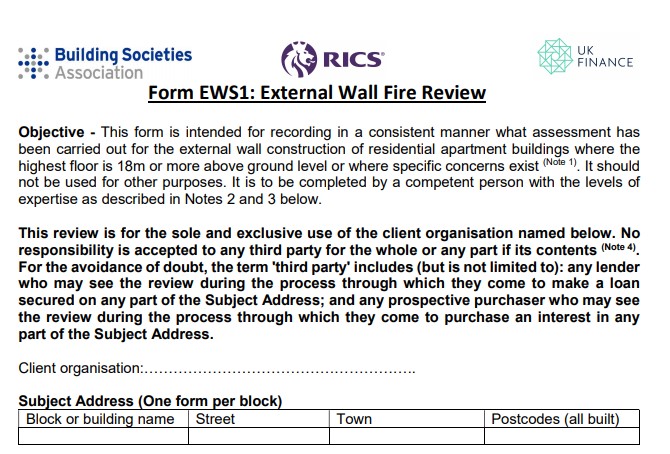External Fire Review Form EWS1

|
The External Fire Review Form (EWS1) was developed by the Royal Institution of Chartered Surveyors (RICS), together with UK Finance and the Building Societies Association (BSA), in December 2019. The primary aim was to give comfort to lenders on the fire safety of high-residential apartment blocks.
In May 2021, CIAT advised its Chartered Architectural Technologists that they could apply for the RICS EWS1 Assessment Training aimed specifically at professionals intending to undertake external wall fire reviews for low to medium risk buildings only.
A statement issued by the UK Government on 21 July 2021 made it clear that the EWS1 forms would only be required for buildings over 18m. Until clarification is received as to how this process will operate, and how those that undertake this work will be insured, the status quo remains, and EWS1 forms may still be required for buildings below 18m in height.
Members and affiliates should be aware that the EWS1 form is intended to be completed by professionals with the necessary experience in fire safety and testing, who are able to access the component parts of an external wall system i.e., cladding, insulation etc. and hold the appropriate professional indemnity insurance (PII). As this is a specialised role that may require samples of cladding material to be taken and tested, especially where the original specification or 'as built' information is no longer available, the completion of this form does not fall within the general scope of an Architectural Technology professional's duties.
As a result, the liabilities that will arise from the completion of the form are unlikely to fall within the scope of your PII. If you are an employee and you are asked to undertake this as part of your duties, you should check that your employer has the necessary cover and will be covering you as part of your employment; this is important to protect you from any possible risk.
For those who are self-employed, if you are asked to complete this form, as a first step, we would recommend contacting your insurance brokers to ensure that your current PII policy will cover this work. Unfortunately, we have been advised that the majority of PI insurers are not prepared to offer cover for this type of work, with the RICS minimum terms now being amended to reflect that this risk can be excluded.
In the event that your current policy is not sufficient, you may need to consider securing separate insurance which would need to be maintained for the duration of the liability period, although such cover may be prohibitively expensive.
CIAT will continue to work with the Ministry of Housing, Communities and Local Government (MHCLG) and RICS to represent its membership and keep them apprised of the latest information on this matter.
This article originally appeared on the CIAT website. It was published on 2 September 2021.
--CIAT
[edit] Related articles on Designing Buildings
- Architectural technologist.
- CIAT articles.
- Cladding for buildings.
- EWS1 forms not required for buildings without cladding.
- Fire Safety Bill.
- Fire safety exclusions - the insurance position.
- High-rise building.
- High rise residential building.
- Medium-rise building.
- Professional indemnity insurance.
- Royal Institution of Chartered Surveyors RICS.
- The Regulatory Reform (Fire Safety) Order 2005.
[edit] External resources External resources
Quick links
[edit] Legislation and standards
Fire Safety (England) Regulations 2022
Regulatory Reform (Fire Safety) Order 2005
Secondary legislation linked to the Building Safety Act
Building safety in Northern Ireland
[edit] Dutyholders and competencies
BSI Built Environment Competence Standards
Competence standards (PAS 8671, 8672, 8673)
Industry Competence Steering Group
[edit] Regulators
National Regulator of Construction Products
[edit] Fire safety
Independent Grenfell Tower Inquiry
[edit] Other pages
Building Safety Wiki is brought to you courtesy of:






